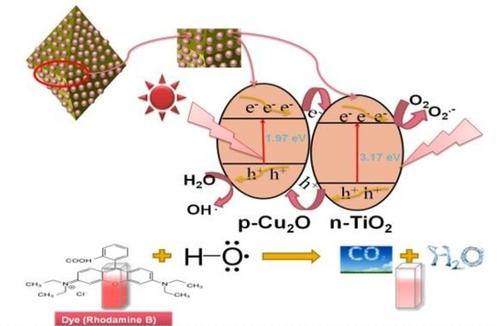当前位置:
X-MOL 学术
›
ChemistrySelect
›
论文详情
Our official English website, www.x-mol.net, welcomes your
feedback! (Note: you will need to create a separate account there.)
A Facile One Pot Synthesis of Cu2O@TiO2: A Nanocomposite Catalyst for Enhanced Visible Light Driven Photocatalysis#
ChemistrySelect ( IF 1.9 ) Pub Date : 2019-02-22 , DOI: 10.1002/slct.201900003 Ganesh Reddy Surikanti 1, 2 , Arun Kumar Bandarapu 1 , Manorama V. Sunkara 1, 2
ChemistrySelect ( IF 1.9 ) Pub Date : 2019-02-22 , DOI: 10.1002/slct.201900003 Ganesh Reddy Surikanti 1, 2 , Arun Kumar Bandarapu 1 , Manorama V. Sunkara 1, 2
Affiliation

|
The highlight of this study is a successful attempt to obtain a visible light active photo catalyst by a single step synthesis procedure. The photocatalytic performance of Cu2O, a p‐type semiconducting oxide with a band gap in the visible region of the solar spectrum is improved by the presence of TiO2 on its surface. Nanocomposites of Cu2O@TiO2 were synthesized by a facile one pot synthesis route. X‐ray diffraction (XRD) studies confirmed the face centred cubic structure of Cu2O but was inconclusive about the TiO2 presence. Field Emission Scanning Electron Microscopy (FE‐SEM) images confirmed the octahedral morphology of the Cu2O particles and the presence of Ti and O on the surface. High Resolution Transmission Electron Microscopy (HR‐TEM) and Selected Area Electron Diffraction (SAED) studies established the presence of nanocrystalline anatase TiO2 on the Cu2O interfaces. The specific role of the nanoparticles of n‐type TiO2 positioned on the p‐type Cu2O in improving photo‐activity and making it visible light active was demonstrated. The photocatalytic activity of the composite was demonstrated by the degradation of a model dye Rhodamine B using visible light. It is observed that the photocatalytic activity is dependent on density of heterojunctions formed in the photo‐system which the nano‐crystalline TiO2 , has very effectively created on the Cu2O surface, which are responsible for the improved photocatalytic response. This work establishes that the in‐situ creation of Cu2O@TiO2 is effective in creating p‐n heterojunctions at the Cu2O@TiO2 interface, which result in arresting the recombination processes, leading to improved photocatalytic performance.
中文翻译:

一种方便的一锅法合成Cu2O @ TiO2:纳米复合催化剂,用于增强可见光驱动的光催化#
这项研究的重点是通过一步合成方法获得可见光活性光催化剂的成功尝试。TiO 2在其表面上存在,可改善在太阳光谱的可见光区具有带隙的Cu 2 O,p型半导体氧化物的光催化性能。通过一种简单的一锅法合成了Cu 2 O @ TiO 2纳米复合材料。X射线衍射(XRD)研究证实了Cu 2 O的面心立方结构,但关于TiO 2的存在尚无定论。场发射扫描电子显微镜(FE‐SEM)图像证实了Cu 2的八面体形态O颗粒以及表面上存在Ti和O。高分辨率透射电子显微镜(HR-TEM)和选择区域电子衍射(SAED)研究确定了Cu 2 O界面上存在纳米晶锐钛矿型TiO 2。展示了位于p型Cu 2 O上的n型TiO 2纳米粒子在改善光活性和使其具有可见光活性方面的特定作用。通过使用可见光降解模型染料若丹明B证明了复合材料的光催化活性。可以看出,光催化活性取决于在纳米TiO 2的光系统中形成的异质结的密度。,已经非常有效地在Cu 2 O表面上产生,其负责改善的光催化反应。这项工作表明,Cu 2 O @ TiO 2的原位形成可有效地在Cu 2 O @ TiO 2界面处形成p-n异质结,从而阻止了复合过程,从而改善了光催化性能。
更新日期:2019-02-22
中文翻译:

一种方便的一锅法合成Cu2O @ TiO2:纳米复合催化剂,用于增强可见光驱动的光催化#
这项研究的重点是通过一步合成方法获得可见光活性光催化剂的成功尝试。TiO 2在其表面上存在,可改善在太阳光谱的可见光区具有带隙的Cu 2 O,p型半导体氧化物的光催化性能。通过一种简单的一锅法合成了Cu 2 O @ TiO 2纳米复合材料。X射线衍射(XRD)研究证实了Cu 2 O的面心立方结构,但关于TiO 2的存在尚无定论。场发射扫描电子显微镜(FE‐SEM)图像证实了Cu 2的八面体形态O颗粒以及表面上存在Ti和O。高分辨率透射电子显微镜(HR-TEM)和选择区域电子衍射(SAED)研究确定了Cu 2 O界面上存在纳米晶锐钛矿型TiO 2。展示了位于p型Cu 2 O上的n型TiO 2纳米粒子在改善光活性和使其具有可见光活性方面的特定作用。通过使用可见光降解模型染料若丹明B证明了复合材料的光催化活性。可以看出,光催化活性取决于在纳米TiO 2的光系统中形成的异质结的密度。,已经非常有效地在Cu 2 O表面上产生,其负责改善的光催化反应。这项工作表明,Cu 2 O @ TiO 2的原位形成可有效地在Cu 2 O @ TiO 2界面处形成p-n异质结,从而阻止了复合过程,从而改善了光催化性能。

















































 京公网安备 11010802027423号
京公网安备 11010802027423号